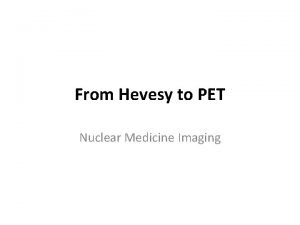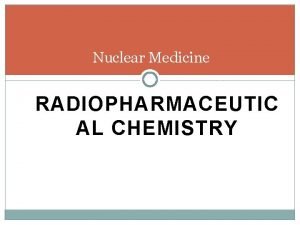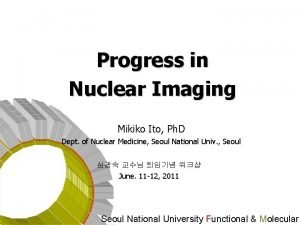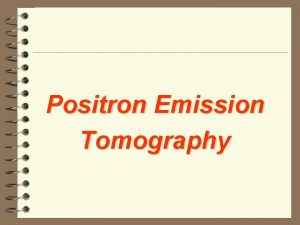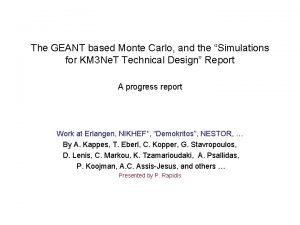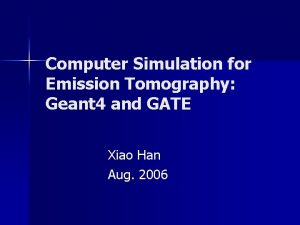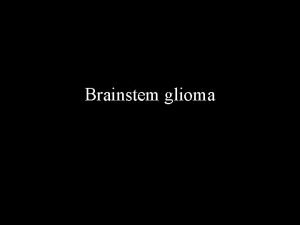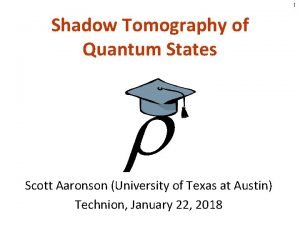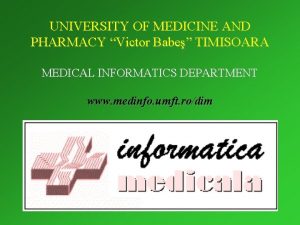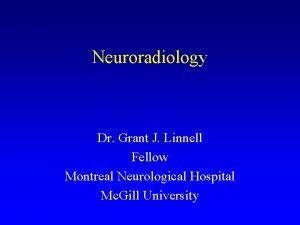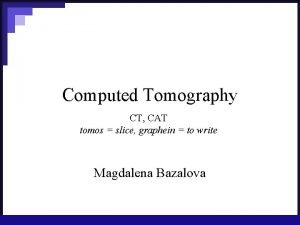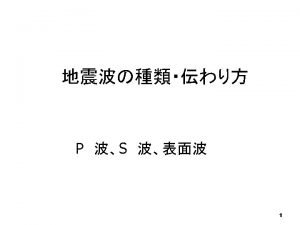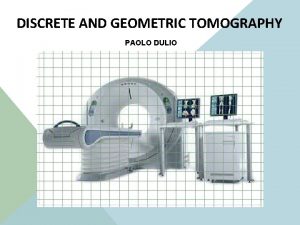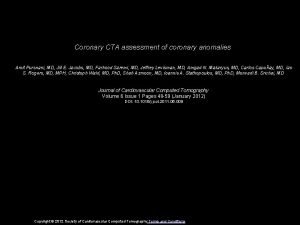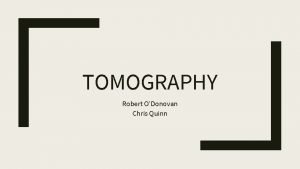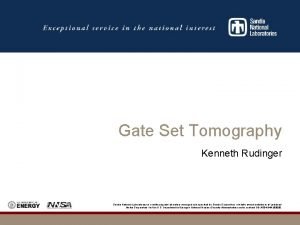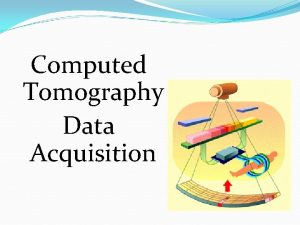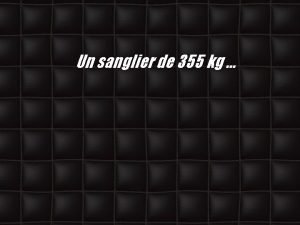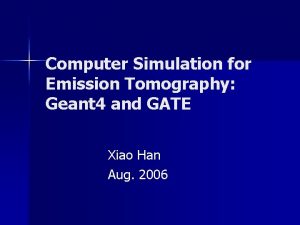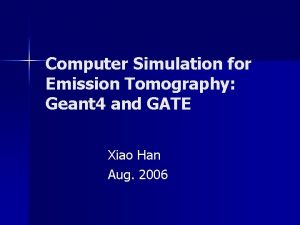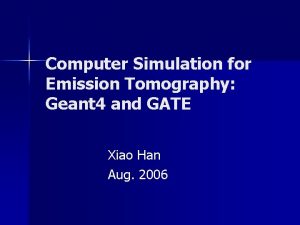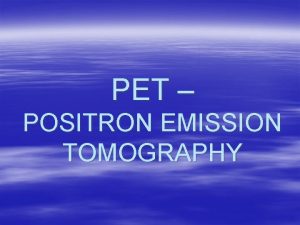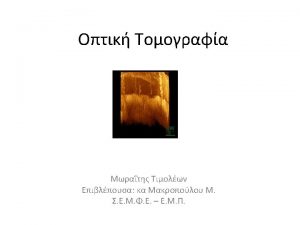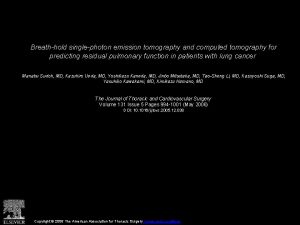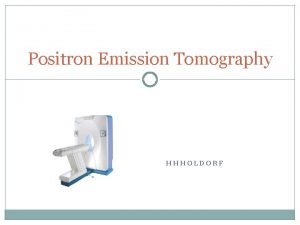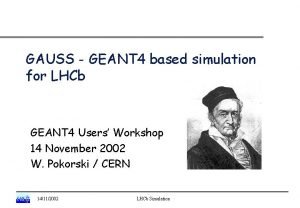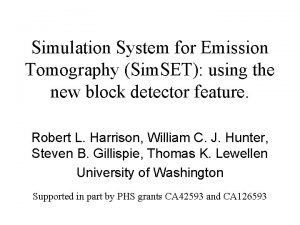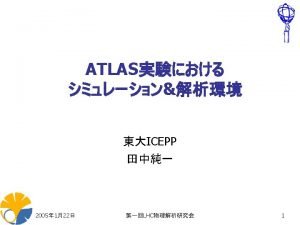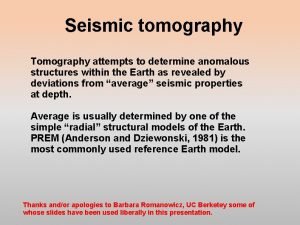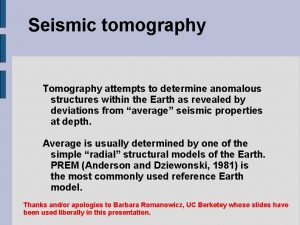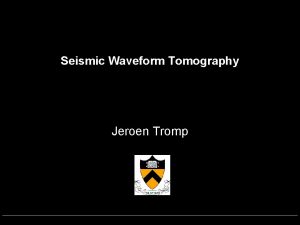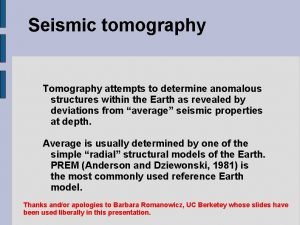Computer Simulation for Emission Tomography Geant 4 and






















- Slides: 22

Computer Simulation for Emission Tomography: Geant 4 and GATE Xiao Han Aug. 2006

Outline Introduction n Geant 4 n GATE n Conclusion n

Introduction n n Computer simulation is a necessary step in designing modern emission tomography instruments Evaluation of simulation packages – – – – History and purpose Features User interface How it works Validation and reliability Cost and accessibility Current users

Geant 4 Toolkit n n n Created by GEANT 4 Collaboration (1998), to provide simulation for any area where particle interacts with matter Provides C++ classes for users to choose to assemble their own packages Main feature – Software engineering – Object-oriented technology

GATE n n Created by Open. Gate Collaboration in 2002 GATE – Geant 4 Application for Tomographic Emission Free Interface – Input: script – Output: n n n online plotter ASCII Root …

Features n n Well validated physics model Sophysticated geometry description Powerful visualization & 3 D rendering Original features specific to emission tomography (temporal synchronization)

GATE work flow Scanner Phantom Source Physics Digitization Acquisition

Scanner geometry

Scanner n Volume shape: – Box – Sphere – Cylinder – Cone – Ellipse, etc. n Material: Geant 4 database & user modifiable

Phantom Similar to definition of scanner geometry or: n Voxellized phantom (e. g. real patient data) n

Source n n Geant 4 class ‘General Particle Source’ Source properties – – – Activity Type of particle Energy distribution Angular emission Spatial distribution Half-life Hoffman brain phantom

Physics modeling n Photon: – – – Photoelectric Compton scattering Rayleigh scattering n Electron: n Electron-positron annihilation: – Ionization – Moller scattering – Bremsstrahlung – Gamma pair noncollinearity

Gamma photon emission hv=511 ke. V radionuclide e+ hv=511 ke. V Positron emission n Positron range n Positron-electron annihilation n Residual momentum n

Gamma photon transport hv<511 ke. V photoelectron recoil e- hv=511 ke. V Rayleigh scattering n Compton scattering n Photoelectric n

Electron transport & energy deposition Ionization n Moller scattering n Bremsstrahlung n hv e- secondary electron e-

Optical photon generation and transport Scintillation n Transport n Surface n – Reflection – Transmission

Physics modeling Positron decay Optical photon transport (before PMT)

Digitization A particle-matter interaction event A physical observable

Acquisition Set time slice n Update time-dependent properties (geometry, activity) at the beginning of time-slices n Proceed particle transport and data acquisition within time-slices, while system is kept static n

Validation Scanner type ECAT EXACT HR+, CPS Studied FOM Spatial resolution Sensitivity Count rates Scatter fraction Count rates Agreement References about 3 % <7% good at activity concentrations < 20 k. Bq/ml about 3 % Jan et al 2005 about 1 % good at activity concentrations < 40 Bq/ml Hi-Rez, Siemens NEC curves Michel et al 2006 Allegro, Philips Count rate Scatter fraction <8% 8% Lamare et al 2006 GE Advance, GEMS Energy spectra Scatter fraction not reported <1% Schmidtlein et al 2006 Micro. PET P 4, Concorde Spatial resolution Sensitivity Miniature Derenzo phantom about 7 % <4% visual assessment Jan et al 2003 Micro. PET Focus, Concorde Spatial resolution Sensitivity about 5 % about 3 % Jan et al 2005 http: //opengatecollaboration. healthgrid. org/physics/validation. html

Current users of GATE n Ecole Polytechnique Fédérale de Lausanne (LPHE), Lausanne University of Clermont-Ferrand (LPC) University of Ghent (ELIS) U 678 INSERM, CHU Pitié-Salpêtrière, Paris Vrije Universiteit Brussel (IIHE) Centre d'Exploration et de Recherche Médicales par Emission de Positons (CERMEP), Lyon Service Hospitalier Frédéric Joliot (SHFJ), CEA-Orsay U 601 INSERM, CHU Nantes Sungkyunkwan University School of Medicine (Division of Nuclear Medicine), Seoul University Louis Pasteur (IRES), Strasbourg University Joseph Fourier (LPSC), Grenoble Forschungszentrum-Juelich (IME), Juelich University of Massachusetts Medical School (Division of Nuclear Medicine), Worcester U 650 INSERM, LATIM, CHU Morvan, Brest University of California (Crump Institute for Molecular Imaging), Los Angeles DAPNIA, CEA-Saclay Memorial Sloan-Kettering Cancer Center (Department of Medical Physics), New York John Hopkins University (Division of Medical Imaging Physics), Baltimore University of Santiago of Chile (USACH) NIMgroup, BIOSIM, National Technical University of Athens Centre de Physique des Particules de Marseille (CPPM), Marseille Laboratoire de Physique Subatomique et des technologies associées (SUBATECH), Nantes

Conclusion GATE is capable to simulate from source decay to optical photon transport n GATE Simulation for Optical photon generation & transport is timeconsuming n
 Positron emission tomography
Positron emission tomography Positron emission tomography
Positron emission tomography Positron emission tomography
Positron emission tomography Positron emission tomography
Positron emission tomography Positron emission tomography
Positron emission tomography Geant simulation
Geant simulation Geant computer
Geant computer Chodorma
Chodorma Shadow tomography of quantum states
Shadow tomography of quantum states Seismic tomography ______.
Seismic tomography ______. Magnetic resonance timisoara
Magnetic resonance timisoara Hematome
Hematome Ring artefact
Ring artefact Seismic tomography
Seismic tomography Tomography
Tomography Dr amit pursnani
Dr amit pursnani What is tomography
What is tomography Kenneth rudinger
Kenneth rudinger Data acquisition system in ct scan
Data acquisition system in ct scan Myrtillier géant
Myrtillier géant Renmap
Renmap Attila sanglier 355 kg
Attila sanglier 355 kg Plus grande pelleteuse du monde
Plus grande pelleteuse du monde
